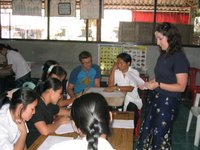Mau's experience at Mae Tao Clinic


Arriving at Mae Tao Clinic is like rolling into hot 'n dusty ramshackle village of semi-permanent mismatched structures. It is literally a community of staff and patients living together on a medical campus. In the mornings there are lots of people milling around, mostly refugees, staff, patients and their families with a few volunteers here and there. There are a few stores too that sell cold beverages, fine Burmese foods, and essentials. You can see laundry hanging in the surrounding non-medical buildings, small makeshift kitchens scattered throughout cooking up breakfast or lunch, children playing in the dusty main road and lots of people healthy and sick sitting in the shade waiting.
We toured the facility and all its many buildings. I don't know what I was expecting it to be like but I was really impressed with the amount of servies available here. It is a regular hospital albeit lacking in the modern equipment, materials and the occasional sink. Services are available for primary care, in-patient departments for both adults and pediatrics, reproductive health, labor and delivery, HIV counseling & testing, a surgical department, prosthetics rehab manufacture and fitting, and a school to train nurses and medics. The entire clinic/hospital is staffed by refugees from Burma.
As volunteers on our first day we were asked to attend to the Adult and Pediatric Out-Patient Departments. I took the Pediatric department by default since Don's expertise is Adults and I currently don't have an expertise. A lot of the patients travel over the border from Myanmar to get health care so it was usually more than just "We're here for a 1-month check-up!" Most of the children had something serious going on. Sometimes I could feel a lump growing in my throat just seeing all these tiny children with malnutrition, strange infections or fevers sitting listless in their parent's arms. When it was slow I would wander over to the pediatric inpatient department and follow up on patients we had admitted earlier that day.
The inpatient department is a huge room divided into individual spaces with wires strung across the ceiling and numbers taped to the wire above each space. Each patient/family got a space with a plastic mat on the floor and a plastic folder for their chart. Some of the patients have been there for weeks. My first day there there were multiple children with TB meningitis, some with Malaria and Malarial encephalitis, a couple being treated for severe malnutrition and young boy with Cerebral Palsy who was abandoned by his father when his mother died from Malaria two months ago. Just heartbreaking cases.
Around clinic you can hear plenty of language variations. Although, I couldn't tell the difference between Thai, Karen or Burmese if you threatened me with a handful of hot chilie peppers. All the charting is done in English and the nurses and medics are expected to learn English. But in a environment where there are hardly any native english speakers most of the staff speak their native languages amongst themselves. So for most of the staff their english skills aren't enough to make up for the average volunteer's meager Thai, Karen or Burmese. My role quickly evolved into that of a medical english instructor. I developed lectures around subjects the nursing medic staff wanted to hear and provided hand-outs full of related medical terminolgy that they could use to improve their charting. Occasionally, the medics would consult me on patients but for the most part they were more proficient than I am with a majority of what they saw.
All in all I recieved more out of this experience than I brought. I thoroughly enjoyed working with the nurses, medics and other fellow volunteers. It was is an incredible opportunity to view the lives of these amazing survivors in this small volatile part of the world. And I'm sure I only scratched the surface.

0 Comments:
Post a Comment
<< Home